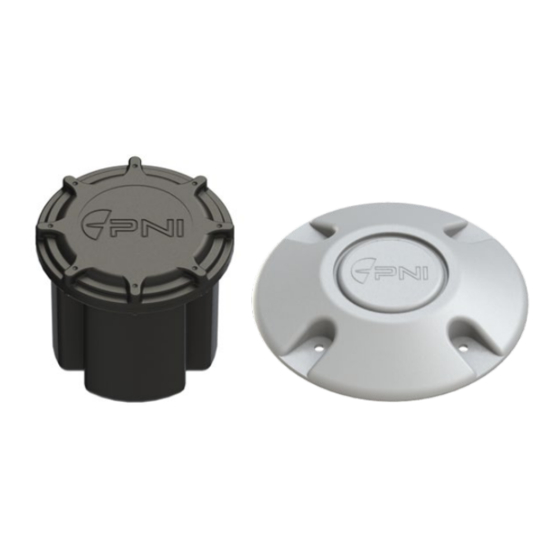Table of Contents
Advertisement
Quick Links
Advertisement
Table of Contents

Summary of Contents for PNI PLACEPOD
- Page 1 ® PLACEPOD VEHICLE DETECTION SENSOR USER MANUAL...
- Page 2 PlacePod® Vehicle Detection Sensor In-Ground and Surface-Mount PlacePod is an in-ground or surface-mounted vehicle detection sensor that communicates with a LoRa gateway to provide real-time parking data. It provides accurate vehicle detection in parking spaces, up to 7 years of battery life, and is stable over temperature fluctuations, even in harsh environments.
- Page 3 Capability for wireless configuration and software updates using Bluetooth Low Energy (BLE) via PNI’s mobile iOS application. • PNI’s Parking Management Application provides a software service for managing and monitoring all parking resources and data. The application is also available for testing and proof of concept purposes.
-
Page 4: Table Of Contents
SYSTEM OVERVIEW ......................6 PLACEPOD PHYSICAL SENSOR ..................7 GATEWAY ........................7 NETWORK SERVICE ......................8 PARKING MANAGEMENT APPLICATION ..............8 PLACEPOD PARKING SOLUTION SETUP AND INSTALLATION ..........9 SETUP AND INSTALLATION OVERVIEW ................9 SET-UP OVERVIEW .......................9 ACTIVATE PLACEPOD ....................10 INSTALLATION SITE SURVEY ..................11 INSTALL THE PLACEPOD .....................12 CALIBRATE THE PLACEPOD ..................12... -
Page 5: Introduction
INTRODUCTION This guide is designed to support the PlacePod device. For questions relating to other elements of a Parking Management system, please contact the provider. The PlacePod User Manual is divided into three sections: • System Functional Elements PNI’s PlacePod sensor is one component of a parking management system. The Sys- tem Functional Elements section describes the system components and preliminary decisions that must be made to enable a smooth implementation. -
Page 6: System Functional Elements
SYSTEM FUNCTIONAL ELEMENTS SYSTEM OVERVIEW The diagram below shows the primary elements of the PlacePod system architecture. A brief description of these functional elements follows. Actility, machineQ, Senet, The Things Network, other public & private networks LoRa PlacePod Sensor Network Service... -
Page 7: Placepod Physical Sensor
PlacePod supports gateways that use the LoRaWAN™ specification for wireless communication. Note that this manual describes the functional components in a linear manner – PlacePod to Gateway to Network Service to Parking Application. However, the network service is generally chosen before the... -
Page 8: Network Service
The same parking space may have RSSI variation of 10 to 15dB when a car is present or when the space is vacant. PNI recommends testing for a -90dBm RSSI without a car in the space as the baseline for gateway setup. For small parking projects, a minimum of two gateways are recommended as redundancy protection. -
Page 9: Placepod Parking Solution Setup And Installation
PNI offers a parking management application that can be used to manage and monitor parking re- sources. PNI’s parking management application is also ideal for testing and proof of concept and in basic system implementations. Please contact your system integrator or the third-party parking application vendor directly for information regarding these options. -
Page 10: Activate Placepod
Using the PlacePod Vehicle Detection Sensor Utility iOS application will activate the PlacePod so that it will join and communicate with the RF network. As such, it is important that the RF network the PlacePod will connect to be available at the time of activation. -
Page 11: Installation Site Survey
INSTALLATION SITE SURVEY Once the PlacePod has been activated it is important to ensure that the sensors are able to communicate with the LoRa network by performing an installation survey. The installation survey is performed in a similar manner to the pre-installation survey described in Section 3.2.2. However, in this case the actual PlacePods and gateways being deployed are tested during installation (but before final installation so adjustments can be made if required). -
Page 12: Install The Placepod
Please refer to the Installation Guide for details on each type of installation. Each PlacePod has a unique ID which can be found on the bottom of the sensor. PNI recommends that you record each sensor ID and match it to the Parking Space ID before installing it into the parking space. Customers generally want to associate a sensor with a physical location. -
Page 13: Appendices
APPENDIX I: GLOSSARY Bluetooth Low Energy (BLE): A wireless technology designed to connect an individual person’s devices. Ferrous: A material containing Iron. Materials containing iron in the vicinity of a PlacePod can interfere with the calibration of the device. Gateway: LPWAN equipment that receives wireless signals from remote devices (such as parking sen- sors) using LoRa bandwidth, and then relays these signals to a network service using a different commu- nications protocol. -
Page 14: Appendix Ii: Placepod Technical Specifications
Activation Type OTAA Certifications FCC (915 MHz), CE (868 MHz) Footnote: * Specifications are subject to change. Table 4-2 PlacePod Vehicle Detection Sensor Default Settings Parameter Default Frequency Sub Band (US915, AU915) Spreading Factor Frame Port Adaptive Data Rate Support... - Page 15 If a Product is defective, transportation charges for the return of the Product to Customer within the United States and Canada will be paid by PNI. For all other locations, the warranty excludes all costs of shipping, customs clearance, and other related charges. PNI will have a reasona- ble time to make repairs or to replace the Product or to credit Customer’s account.

















Need help?
Do you have a question about the PLACEPOD and is the answer not in the manual?
Questions and answers